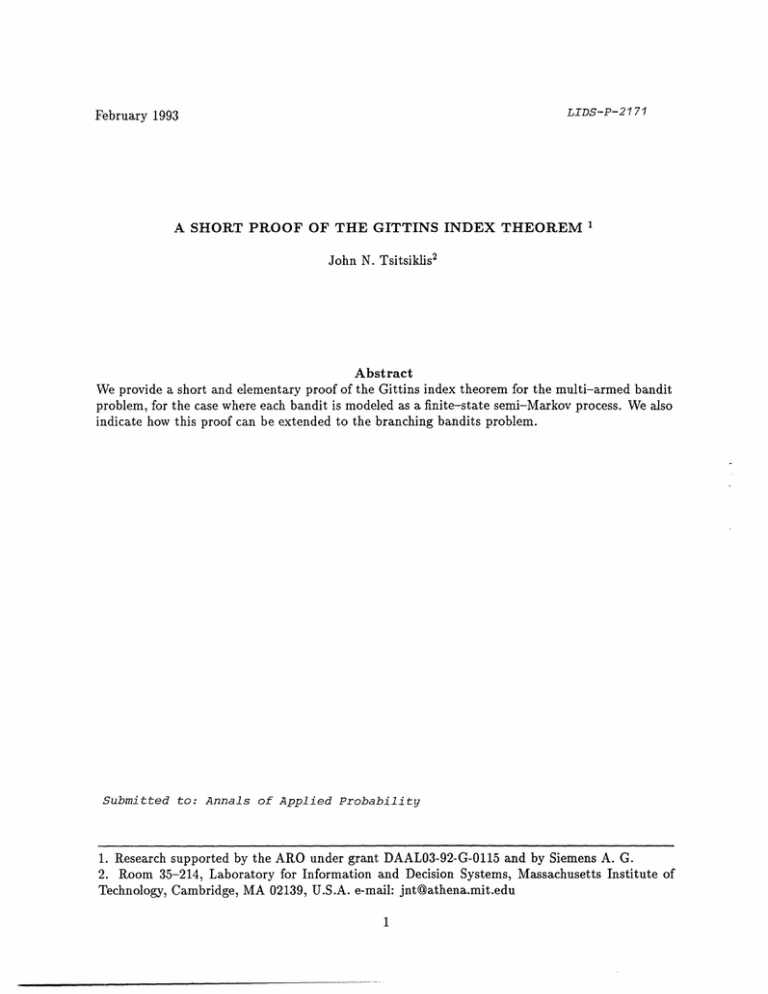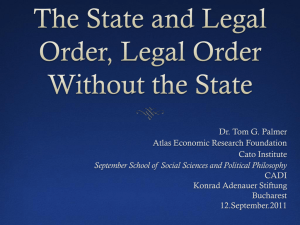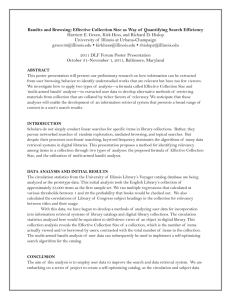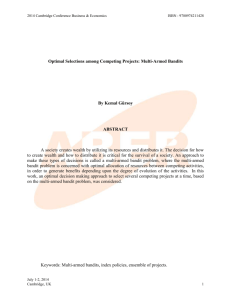February 1993 GITTINS INDEX THEOREM
advertisement

February 1993
LIDS-P-2171
A SHORT PROOF OF THE GITTINS INDEX THEOREM
John N. Tsitsiklis 2
Abstract
We provide a short and elementary proof of the Gittins index theorem for the multi-armed bandit
problem, for the case where each bandit is modeled as a finite-state semi-Markov process. We also
indicate how this proof can be extended to the branching bandits problem.
Submitted to: Annals of Applied Probability
1. Research supported by the ARO under grant DAAL03-92-G-0115 and by Siemens A. G.
2. Room 35-214, Laboratory for Information and Decision Systems, Massachusetts Institute of
Technology, Cambridge, MA 02139, U.S.A. e-mail: jnt@athena.mit.edu
1
I. INTRODUCTION
There is a long history of alternative proofs of the Gittins index theorem for the multi-armed
bandit problem. The original proof of Gittins and Jones [GiJ74] relied on an interchange argument.
A different interchange argument was provided by Varaiya et al. [VWB85] and was simplified further
in [Wal88]. The simplest interchange argument available seems to be the one by Weiss [Wei88] which
in fact establishes an index theorem for the more general branching bandits model. A different proof,
based on dynamic programming, was provided by Whittle [Whi80] and subsequently simplified by
Tsitsiklis [Tsi86]. Weber [Web92] has outlined a new proof that avoids any calculations and rests
on more qualitative reasoning. Finally, a proof based on a polyhedral characterization of a suitably
defined "performance region" has been provided by Tsoucas [Tso91], for the case of the average-cost
Klimov problem, and by Bertsimas and Nino-Mora [BeN93] for many other classes of multi-armed
bandit problems.
This paper presents yet another proof of the same result. This proof has some common
elements with the proof in [Wei88] but appears to be simpler in that it is based on a simple
inductive argument and uses only trivial calculations. The induction is in terms of the cardinality
of the state spaces of the bandits involved and, for this reason, the proof is valid only for the case
of finite-state bandits.
The rest of the paper is organized as follows. Section 2 presents the model to be employed
and the proof of our main result. Section 3 contains some discussion on how to handle the more
general branching bandits problem.
II. THE MULTI-ARMED BANDIT MODEL
There are n bandit processes. The ith such process is a semi-Markov process with a finite
state space Xi. We assume, for simplicity, that the state spaces of the different bandits are disjoint
and we let X = X1 U ... U Xn. If the ith bandit is at some state x E Xi and is selected to be
"played", then a random reward R(x) is received and the bandit remains active over a time period
of random length T(x). After T(x) time units, the play is completed and the bandit moves to a
random new state y. At that point, we are free to choose the same or another bandit to be played.
We assume that the joint probability distribution of the random vector (T(x), R(x), y) is known
and is the same for every play of bandit i for which bandit i is at the same state x E Xi. In addition,
the random vectors corresponding to different plays of the same or of different bandits are assumed
to be statistically independent.
A policy for the multi-armed bandit problem is defined as a mapping ir: Xl x ... x X,
{1, ... , n} which at time zero and at any play completion time chooses a bandit to be played next,
as a function of the current states of the n bandits. Given a particular policy, the time ti at which
the ith play starts and the reward Ri received at that time are well-defined random variables. Let
6 > 0 be a discount rate. We are interested in the problem of finding a policy that maximizes the
expected discounted reward
E
i=
e
for every initial state.
We now comment on some consequences of the general fact that it is only E[R(x)] and not the
entire probability distribution of R(x) that matters. Let us fix a particular policy. Let xi be the
state of the bandit that is played at the ith play and let 'Fi stand for all random variables realized
during the first i - 1 plays. In particular, ti and xi are determined by the outcomes of the first
i - 1 plays and are contained in F'i. Conditioned on Yi, the expected discounted reward resulting
from the ith play is given by
e tiE[R(xi) I xsi.
2
Let us now consider the following alternative reward structure: whenever a bandit at some state x
is played, then rewards are received throughout the duration of that play at a constant rate r(x),
where
r(x) =
E[R(x)]
(2.1)
E[ f
e
dt]
Under this new reward structure, the expected reward resulting from the ith play, conditioned on
.Fi, is given by
ti+T(xi)
E[j
T(xci)
e- 3 tr(xi)dt I Fi = e-3tir(xi)E j
eertdt I xi] = e-tiE[R(xi) I xi],
where the last equality follows from (2.1). It follows that under either reward structure, the infinitehorizon expected discounted reward of any policy is the same. We will be using this fact later in
our proof.
We say that a policy is a priority rule if there is an ordering of the elements of X = X1 U... Xn
such that at each decision point, the bandit whose state is ordered highest is chosen. Our basic
result is the following.
Theorem 2.1: If each Xi, i = 1,..., n, is finite, then there exists a priority rule which is optimal.
Proof: Let N be the cardinality of the set X. The proof proceeds by induction on N.
If N = 1, we have a single bandit and the only available policy is trivially a priority rule.
Let us now assume that the result is true for all multi-armed bandit problems for which
N = K, where K is some positive integer. We consider a multi-armed bandit problem for which
N = K + 1, and we will show that there exists an optimal policy which is a priority rule. This will
complete the induction and the proof of the theorem.
Let us pick some state s* E X such that r(S*) = max.ex r(x). Let i* be such that s* E Xi..
The following lemma states that s* can be chosen as a top priority state.
Lemma 2.1: There exists an optimal policy that obeys the following rule: whenever bandit i* is
at state s*, then bandit i* is played.
Proof: Consider an optimal policy ir. Suppose that at time 0, bandit i* is at state s*. If policy 7r
chooses to play bandit i*, then there is nothing to prove. Suppose now that 7r chooses some other
bandit to play. Define the random variable 7 as the first time at which bandit i* is played under
policy 7r. (We let r = oo if bandit i* is never played.)
We now define a new policy, call it 7r', which plays bandit i* once and from then on mimics
the actions of policy Ir. However, when (and if) policy 7r plays bandit i* for the first time, policy
wr skips that play of bandit i*. Let T(t) be the reward rate, as a function of time, under policy 7r.
Using the definition of s*, we have T(t) < r(s*) for all t.
The expected discounted reward J(r) under policy 7r is given by
fj
J(r) = E[
O
(t)e/'3 t di + e
O
jT(s*
r(s*)e-t
A dt + jTiT+T(s*) T(t)e t-3 dd].
Similarly, the expected discounted reward J(7r') under policy 7r' is given by
r(s*)e - t dt + e T(S - ) jT(t)e
J(r') = E[ J
-
/
t dt +
I
(t)e
&t-
dt.]
+T(s-)
We wish to show that J(r') > J(t). Equivalently, that
E[( - e -
'r)
r
r(s*)e/- t dt] > E(1-e
e - T(s)) j
---·--··-·
-·I1III~IILC I~-·1-·1------
T(t)e-It dt].
(2.2)
We note that if T(t) were equal to r(s*) for all t, then the two sides of Eq. (2.2) would be equal.
This observation and the fact T(t) < r(s*) show that Eq. (2.2) is valid and, therefore, J(7r') > J(7r).
Since 7r was assumed optimal, 1r' is also optimal. But if it is optimal to give top priority to state
s* at time 0, then (by the optimality of stationary policies) it is also optimal to give top priority
to state s* at every decision time.
q.e.d.
Lemma 2.1 states that there exists an optimal policy within the set of policies that give top
priority to state s*; call this set of policies II(s*). We will now consider the problem of finding a
policy which is optimal within the set II*(s).
If s* is the only possible state of bandit i*, then the policy that always plays bandit i* is
evidently optimal and is a priority rule. We henceforth assume that Xi* is not a singleton. Suppose
that bandit i* is in some state x $ s* and that this bandit is played. If this play causes a transition
to state s*, bandit i* will be played again and again until eventually a transition to some state
different from s* results. We can view this succession of plays as a single (composite) play which
cannot be interrupted due to our restriction to II(s*). This single play has a random duration
T(x) equal to the total time elapsed until a transition to a state different than s*. Furthermore,
by the discussion preceding the statement of Theorem 2.1, the reward of every policy remains the
same if the discounted reward f 0 T(r) e-ftY(t) dt received during this composite play is replaced by
a constant reward rate equal to
(x) = E[fJ)
( = E[
e
t(t)dt]
-Pt(2.3)
(2.3)
to be received throughout the duration of this composite play. We may thus replace bandit i* by a
new bandit in which state s* is absent, T(x) and r(x) are replaced by T(x) and i(x), respectively,
and the transition probabilities are suitably modified. We call this procedure "reducing bandit i*
by removing state s*."
The above argument shows that the problem of finding an optimal policy within the class
II(s*) is a new multi-armed bandit problem for which the sum of the cardinalities of the state
spaces of the different bandits is equal to K. The induction hypothesis shows that there exists a
priority rule fr which is optimal for the latter problem. It follows that there exists an piority rule
which is optimal for the original problem: give top priority to state s* and follow the priority rule
*r for the remaining states.
Q.E.D.
To every state x E X, we associate a number 7(x), which we will call an index, using the
following procedure:
Index Algorithm:
a) Pick a state s* such that r(s*) = maxxex r(x) and let y(s*) = r(s*). Let i* be such that
s* E Xi*.
b) If Xi. is a singleton, remove bandit i*. Else, reduce bandit i* by removing state s*. Go back
to (a).
From the proof of Theorem 2.1, it is apparent that the statistics of the random variables T(x)
and r(x), as well as the transition probabilities of the reduced bandit i* are completely determined
by the corresponding statistics and transition probabilities of the original bandit i*. This shows that
the indices of the various states of a particular bandit are completely determined by the statistics
associated with that bandit. In other words, the index algorithm can be carried out separately for
each different bandit, still yielding the same index values.
The Gittins index theorem establishes something more than Theorem 2.1. In particular, not
only does it show that there exists a priority policy which is optimal, but also that an optimal
4
priority ordering can be found by ordering the states according to the numerical values of a certain
index which can be computed separately for each bandit. We can also get this stronger result as
follows:
Theorem 2.2: Let the index of each state be determined according to our index algorithm. Then,
any priority policy in which states with a higher index have higher priority, is optimal.
Proof: The proof of Theorem 2.1 shows that any priority policy that orders the states in the same
order as they are picked by the index algorithm is optimal. Therefore, it only remains to show that
x can be picked before y by the index algorithm if and only y(x) > y(y). Given the recursive nature
of the algorithm, it suffices to show that if state s* is the first one picked by the index algorithm,
and q* is the next state to be picked, then y(s*) > y(q*). Let i* be such that s* E Xi*. If q* E Xi*,
then, using Eq. (2.3), we have
(q*) = r(q*)
<
maxr(x) = r(s*) = y(s*).
XEX
If on the other hand q* 4 Xi., then y(q*) = r(q*) < r(s*) = y(s*).
Q.E.D.
For the case of discrete-time Markov bandits, our index algorithm is the same as the one
in [VWB85]. This reference, as well as [Wal88], provides some more detail on how the needed
calculations can be carried out. Our algorithm is also a special case of the algorithm in [Wei88].
III. DISCUSSION
The proof given here is very simple and it is quite surprising that it was not known earlier.
Perhaps a reason is that for the proof to go through, we have to consider semi-Markov bandits
rather than the usual discrete-time Markov bandits.
We finally remark that our proof is easily extended to cover the case of arm-acquiring bandits
[Whi81] and the even more general case of branching bandits, thus recovering the results of [Wei88].
We assume that the reader is familiar with the framework of [Wei88] and we only point out a few
minor modifications of the proof of Theorem 2.1 that are needed. Instead of assuming that the
different bandits have disjoint state spaces, we now assume that all bandits share the same state
space. We then use induction on the cardinality of this common state space. As in the proof of
Theorem 2.1, we pick a top priority state s* whose reward rate is maximal. We then "eliminate"
state s* and form a reduced bandit as follows: if a bandit at some state x 0 s* is played, then the
play lasts until all type s* descendants of that bandit have been eliminated; the reward rate during
this composite play is also suitably defined, similarly with Eq. (2.3). The resulting index algorithm
is identical to the algorithm in [Wei88].
REFERENCES
[BeN93] D. Bertsimas and J. Nino-Mora, "Conservation laws, extended polymatroids and the multiarmed bandit problem: a unified polyehdral approach", in preparation, 1993.
[GiJ74] J. C. Gittins, D. M. Jones, "A dynamic allocation index for the design of experiments," in J.
Gani, K. Sarkadi and I. Vince (Eds.), Progress in Statistics, European Meeting of Statisticians,
1972, Vol. 1, North Holland, 1974, pp. 161-173.
[Tsi86] J. N. Tsitsiklis, "A lemma on the multi-armed bandit problem", IEEE Transaction on Automatic Control, 31, 1986, pp. 576-577.
[Tso91] P. Tsoucas, "The region of achievable performance in a model of Klimov", research report,
I.B.M., 1991.
[VWB85] P. Varaiya, J. Walrand and C. Buyukkoc, "Extensions of the multi-armed bandit problem: the
discounted case", IEEE Transaction on Automatic Control, Vol. AC-30, 5, 1985, pp. 426-439.
[Wal88] J. Walrand, An Introduction to Queueing Networks, Prentice Hall, Englewood Cliffs, NJ, 1988.
5
[Web92] R. Weber, "On the Gittins index for multiarmed bandits", The Annals of Applied Probability,
Vol. 2, 4, 1992, pp. 1024-1033.
[Wei88] G. Weiss, "Branching bandit processes", Probability in the Engineering and Informational
Sciences, Vol. 2, 1988, pp. 269-278.
[Whi80] P. Whittle, "Multi-armed bandits and the Gittins index", J. Royal Statistical Society, B, 42,
2, 1980, pp. 143-149.
[Whi81] P. Whittle, "Arm acquiring bandits", Annals of Probability, Vol. 9, 1981, pp. 284-292.
6







